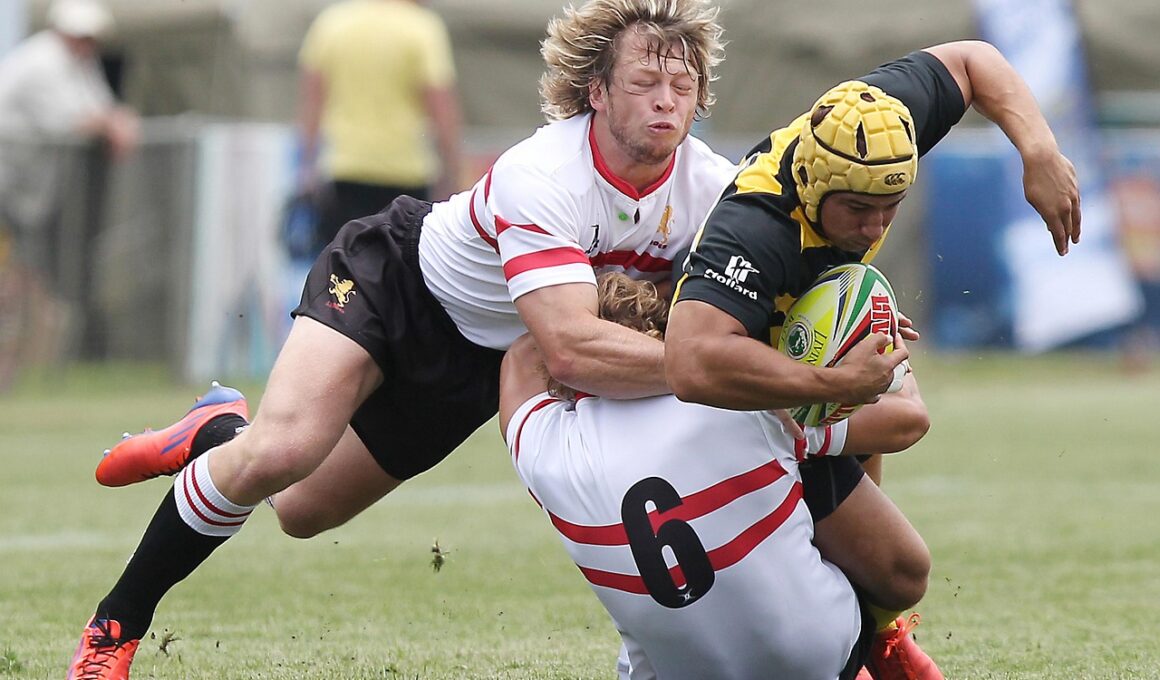Top Injury Prevention Strategies for Rugby Players
Rugby is a physically demanding sport, which makes players susceptible to various injuries. Preventing these injuries is essential for maintaining performance and longevity in the game. A comprehensive plan for injury prevention involves several strategies that focus on physical conditioning, proper techniques, and injury awareness. Players should engage in sport-specific training, which emphasizes not only cardiovascular fitness and strength but also flexibility and coordination. A well-structured warm-up routine is crucial before practices and games, as this prepares the body for the high-intensity activities to follow. Additionally, incorporating strength training routines tailored specifically for rugby players can prove beneficial. Focus areas include the legs, core, and shoulders to enhance overall performance. Furthermore, players should be educated on proper tackling techniques and safe gameplay to minimize the risk of injuries. Awareness about the potential hazards on the field and maintaining situational awareness is equally important. Effective communication among teammates can also avert dangerous situations, thereby enhancing overall safety during games and practices. By prioritizing these strategies, rugby players can significantly reduce their risk of injuries and enjoy a long, fulfilling athletic career.
Another important aspect of injury prevention for rugby players is the role of recovery and rehabilitation in their training regimen. After intense training sessions or matches, the body undergoes stress, which requires adequate time for recovery. This means incorporating rest days and sleep into the training schedule should be a priority. Additionally, players should pay attention to their nutrition, ensuring that they consume a balanced diet rich in protein and carbohydrates, which aids in muscle recovery and replenishes energy stores. Hydration is another critical factor to consider, as dehydration can increase the risk of muscle cramps and fatigue. Implementing mobility exercises and stretching after sessions aids in maintaining flexibility and preventing strains. Should an injury occur, it is imperative for players to follow a structured rehabilitation program, which may include physical therapy supervised by professionals. Such programs are designed to safely restore function and strength before returning to play. Also, using ice, compression, and elevation tactics can relieve swelling, thereby promoting healing. By understanding and implementing this recovery process, players enhance their resilience against future injuries, thus maintaining peak performance levels on the field.
Strength and Conditioning Programs
The foundation of effective injury prevention lies in strength and conditioning programs specifically designed for rugby players. These programs should be customized to address the unique physical demands of rugby, focusing on strength, power, and endurance. Strength training is vital because it not only boosts muscle strength but also fortifies ligaments and tendons, which are critical in resisting sports-related injuries. Incorporate compound movements such as squats, deadlifts, and bench presses to engage multiple muscle groups effectively. Plyometric exercises can enhance explosive power, which is beneficial in rugby scenarios such as sprinting and tackling. Moreover, incorporating agility drills can significantly improve players’ ability to change direction swiftly while maintaining balance and reducing injury risks. Conditioning exercises, like interval running, simulate the match fitness demands, allowing players to build stamina. Another key aspect of strength and conditioning is periodization, which helps players avoid overtraining by cycling through different training phases. By adhering to a well-structured strength and conditioning program tailored to rugby, players can minimize injury risks while promoting overall athletic performance, enabling them to compete at the highest levels.
In addition to strength and conditioning, players should prioritize skill development to prevent injuries effectively. Understanding the fundamentals of rugby techniques is vital for player safety on the field. This includes proficiency in tackling, scrummaging, and passing, as poor execution can lead to injuries, not just to oneself but also to others. Teams should regularly incorporate drills that emphasize proper technique during practice sessions. Coaches can structure these drills to spotlight high-risk scenarios, allowing players to practice minimizing potential injuries during a game. Furthermore, it’s essential that players are educated about the proper use of protective gear, such as headgear and mouthguards, which can help avert injuries during intense matches. Frequent evaluations of player performance and techniques can help identify areas that require improvement and facilitate timely corrections. Additionally, players should be encouraged to speak up when they feel discomfort or pain, ensuring that minor injuries do not escalate into more severe issues. Through continual skill development, proper technique implementation, and careful assessment, rugby players can reduce their injury risk significantly while enhancing their overall competence on the pitch.
Warm-Up and Cool-down Exercises
Implementing a structured warm-up and cool-down routine is paramount for injury prevention in rugby. A proper warm-up increases blood flow to muscles, elevating their temperature and preparing them for the physical demands of the game. Incorporate dynamic stretching and mobility exercises that target key muscle groups to boost flexibility and range of motion, which are crucial for effective performance. A sample warm-up might include exercises such as high knees, butt kicks, and arm circles, all designed to activate the body gradually. This routine should last approximately 10 to 15 minutes, ensuring adequate preparation. After the match or training session, a cool-down routine is equally vital. Gradually lowering the heart rate through light jogging or walking before static stretching allows the body to recover more effectively. Stretching major muscle groups, focusing on legs, back, and shoulders, can help release tension and prevent stiffness. Engaging in these practices consistently fosters better muscle recovery and flexibility over time. Increasing awareness and discipline around warm-ups and cool-downs can transform injury prevention efforts, leading to a healthier, more resilient athlete.
Another proactive strategy in injury prevention is the integration of mental conditioning techniques. The mental aspect of sport is often overlooked, yet it plays a significant role in athletic performance and injury prevention. Stress and anxiety can lead to loss of focus and increase the likelihood of injury for rugby players. Incorporating mindfulness techniques such as visualization, meditation, and breathing exercises can help players enhance their mental resilience. Visualization techniques can prepare players for high-pressure situations by mentally rehearsing their actions on the field. Regularly practicing stress-relief strategies can foster a clearer mindset, enabling better decision-making and awareness during gameplay. Furthermore, team-building activities can also improve player chemistry and reduce stress, ultimately leading to a more cohesive and supportive environment. Players should be encouraged to communicate and express their thoughts and feelings freely, further promoting a positive mentality. When athletes feel mentally supported and equipped to handle pressure, they are likely to exhibit better performance while decreasing the risk of injuries. Understanding the relationship between mental well-being and physical performance is essential in developing comprehensive injury prevention strategies for rugby players.
Monitoring and Evaluation
Finally, establishing a system for monitoring and evaluating injury risks is crucial for ongoing injury prevention in rugby. Injuries can often result from accumulated fatigue, overtraining, or poor execution of skills, thus necessitating a proactive approach to evaluate each player regularly. Coaches and sports staff should keep track of player performance data, including training loads and injury history. By analyzing this data, trends and potential risk factors can be identified, allowing for timely adjustments in training programs. Regular fitness assessments can help gauge progress and establish individual goals catering to each player’s strengths and weaknesses. Furthermore, organizing periodic check-ins to discuss players’ physical and mental well-being can help identify issues before they escalate. Open communication and collaboration between players, coaches, and medical staff foster a supportive environment that prioritizes injury prevention. By investing time in monitoring and evaluating players, teams can adopt a proactive approach, ensuring the health and safety of all players. This dedication to consistent assessment will contribute significantly to nurturing a robust and enduring rugby team.
Conclusion and Future Directions
In conclusion, the integration of various injury prevention strategies is vital for rugby players in ensuring their safety and optimizing performance. By emphasizing strength and conditioning, skill development, proper warm-ups, and mental conditioning, players can significantly lower their injury risks while enhancing their game. Continuous evaluation and monitoring of players also play a central role in adapting training protocols for better safety measures. Education on the importance of recovery, nutritional support, and injury awareness must remain at the forefront of training programs. The rugby community must continue to explore innovative methods and resources that address injury prevention to support athletes mainstream effectively. Collaborating with sports scientists, physiotherapists, and coaches can lead to improved approaches tailored to each player’s needs. Such advancements will ensure that athletes not only thrive in their respective games but also stay healthy throughout their careers. By fostering a culture of injury prevention, we cultivate a new generation of rugby players who prioritize their safety while enjoying their sports journey. With continued dedication and strategic planning, the future of rugby injury prevention appears promising.


